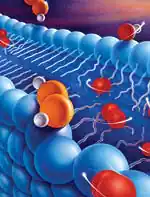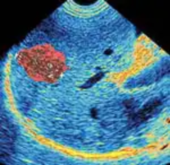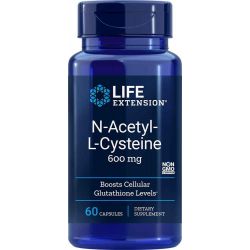N-acetylcysteine (NAC)
 Entering the twenty-first century, one of our greatest health threats is pollutants. Uncounted toxic chemicals pollute what we eat, drink, and breathe. The battle against toxins is largely waged in the liver. Despite being the largest glandular organ, the liver still bears a disproportionate burden in ridding the body of toxins. Those pollutants that cannot be processed and disposed of are stored in fatty tissues, first in the liver and then in other parts of the body. Over time, this can cause long-term harm to the liver.
Entering the twenty-first century, one of our greatest health threats is pollutants. Uncounted toxic chemicals pollute what we eat, drink, and breathe. The battle against toxins is largely waged in the liver. Despite being the largest glandular organ, the liver still bears a disproportionate burden in ridding the body of toxins. Those pollutants that cannot be processed and disposed of are stored in fatty tissues, first in the liver and then in other parts of the body. Over time, this can cause long-term harm to the liver.
A Powerful Antioxidant
 N-acetylcysteine, derived from the simple amino acid cysteine, provides significant protection against a broad array of modern toxins. These include acrolein (found in cigarette smoke and auto exhaust), paraquat (a toxic herbicide), and the side effects of cyclophosphamide, adriamycin (both anticancer drugs) and halothane (an anesthetic).
N-acetylcysteine, derived from the simple amino acid cysteine, provides significant protection against a broad array of modern toxins. These include acrolein (found in cigarette smoke and auto exhaust), paraquat (a toxic herbicide), and the side effects of cyclophosphamide, adriamycin (both anticancer drugs) and halothane (an anesthetic).
Research indicates that in addition to providing toxin protection, N-acetylcysteine is a selective immune system enhancer, improving symptoms and preventing recurrences of common lung-related illnesses such as chronic bronchitis.1 N-acetylcysteine may further protect lung tissue against other conditions through its antioxidant activity.2
Among the most damaging pollutants in the human body are reactive oxygen intermediates. More commonly called “free radicals,” these are the toxic waste products of normal cellular metabolism. Left unchecked, free radicals interrupt the cellular regenerative process, eventually damaging cells. Free-radical-mediated mechanisms have also been suggested as contributing to the development of several neurodegenerative diseases,3,4 and are even suspected of being a major factor in the body’s aging process.
Antioxidants scavenge free radicals, effectively neutralizing them and contributing to more-efficient liver function. Antioxidants may also improve food quality and stability by inhibiting the free radical oxidation of food during its processing and storage.5 N-acetylcysteine is a vital antioxidant whose demonstrated beneficial characteristics include the scavenging of potent hydroxyl radicals and diminished production of hydrogen peroxide (H2O2).6
Effects on Glutathione
 The picture beside shows glutathione crystals. A naturally occuring tripeptide composed of the amino acids glutamic acid, glycine, and cysteine, glutathione is an important antioxidant.
The picture beside shows glutathione crystals. A naturally occuring tripeptide composed of the amino acids glutamic acid, glycine, and cysteine, glutathione is an important antioxidant.
In addition to these beneficial properties, N-acetylcysteine helps the body convert and synthesize glutathione, an amino acid compound that consists of glycine, L-glutamic acid, and L-cysteine, and is found in every cell. While glycine and L-glutamic acid are plentiful in our diets, the amount of glutathione our bodies can produce is limited by their store of cysteine, which sometimes is in short supply. Supplementation with N-acetylcysteine thus helps the body produce glutathione at more beneficial levels.
Intracellular glutathione levels affect the ability of lung phagocytes—white blood cells that ingest and destroy bacteria and cellular debris—to do their job properly. Glutathione’s ability to scavenge free radicals enhances cellular function while helping the liver remove chemicals (such as drugs and pollutants) that are foreign to the body.
Glutathione is often considered the body’s most important antioxidant because of its location within the cell, which enhances its ability to neutralize free radicals. Increased glutathione levels have demonstrated particularly positive effects on those with severely depleted immune systems, such as HIV patients.7,8 Normal glutathione levels also show promise in the treatment of several lung disorders.9
Other Benefits
 The picture beside shows the cell membrane lipid bilayer (blue) being damaged by oxygen free radicals (red and white clusters).
The picture beside shows the cell membrane lipid bilayer (blue) being damaged by oxygen free radicals (red and white clusters).
The list of conditions that can be improved with N-acetylcysteine supplementation seems to grow each year. For example, N-acetylcysteine recently was shown to reduce the proliferation of certain cells lining the colon, and it may reduce the risk of colon cancer in people with recurrent polyps in the colon.10 N-acetylcysteine has been used in connection with chronic obstructive pulmonary disease, angina pectoris, gastritis, and heart attack (intravenously immediately following a myocardial infarction).
More recently, patients with other neurodegenerative conditions including amyotrophic lateral sclerosis, multiple sclerosis, diabetic neuropathy, and Alzheimer’s disease have been treated with N-acetylcysteine. These treatment outcomes indicate that if improvement in antioxidant status occurs, the potential exists for arresting progression of the disease and, in some cases, even improving the sufferer’s condition. N-acetylcysteine, with its proven safety and various antioxidant capabilities, may be a promising new tool in the treatment of such disorders.
Benefits for the Kidney and Liver
 N-acetylcysteine has demonstrated benefits for people with pre-existing kidney damage who are undergoing coronary angiogram tests and are at risk for further kidney damage from the injected dye used to visualize the coronary arteries. Oral administration of N-acetylcysteine reduced by 86% the incidence of kidney damage in people undergoing this procedure.11 Formation and recurrence of kidney stones may also be circumvented by N-acetylcysteine supplementation.12
N-acetylcysteine has demonstrated benefits for people with pre-existing kidney damage who are undergoing coronary angiogram tests and are at risk for further kidney damage from the injected dye used to visualize the coronary arteries. Oral administration of N-acetylcysteine reduced by 86% the incidence of kidney damage in people undergoing this procedure.11 Formation and recurrence of kidney stones may also be circumvented by N-acetylcysteine supplementation.12
 The picture beside shows sonogram of liver cancer: the hepatocarcinoma is shown in red. Hepatocarcinoma is a malignancy arising from the hepatocytes, the epithelial cells of the liver.
The picture beside shows sonogram of liver cancer: the hepatocarcinoma is shown in red. Hepatocarcinoma is a malignancy arising from the hepatocytes, the epithelial cells of the liver.
Oral supplementation with N-acetylcysteine has even been used successfully in two cases to treat a rare syndrome known as pseudoporphyria that complicates kidney dialysis.13 The condition has no other known treatment.
The antioxidant activity of N-acetylcysteine helps protect the liver from potentially adverse effects of exposure to a broad range of toxic chemicals, including those chemicals that can poison the body through cumulative use. For example, N-acetylcysteine counteracts acetaminophen toxicity and has been routinely used at very high levels in hospitals for patients with acetaminophen poisoning. It has also been shown to be effective in treating liver failure from causes other than acetaminophen poisoning, including hepatitis and other drug toxicity.14
Supplementation Guidelines
 While cysteine, the amino acid from which N-acetylcysteine is derived, is found in most high-protein foods, N-acetylcysteine is not derived from dietary sources. Optimal levels of supplementation are uncertain, but a considerable proportion of the research studies on N-acetylcysteine used 250-1,500 mg per day. According to one study, N-acetylcysteine may increase urinary zinc excretion,15 leading the study authors to recommend that zinc and copper be taken concurrently when supplementing with N-acetylcysteine for extended periods.
While cysteine, the amino acid from which N-acetylcysteine is derived, is found in most high-protein foods, N-acetylcysteine is not derived from dietary sources. Optimal levels of supplementation are uncertain, but a considerable proportion of the research studies on N-acetylcysteine used 250-1,500 mg per day. According to one study, N-acetylcysteine may increase urinary zinc excretion,15 leading the study authors to recommend that zinc and copper be taken concurrently when supplementing with N-acetylcysteine for extended periods.
N-acetylcysteine has no demonstrated sedative or stimulant effects, and tolerance is excellent for the vast majority of people who take it regularly. As a potentially powerful antidote to our polluted environment, N-acetylcysteine is a simple yet profound way to help protect the body against the ravages of the modern industrialized world.
Material used with permission of Life Extension. All rights reserved.
- Boman G, Backer U, Larsson S, Melander B, Wahlander L. Oral acetylcysteine reduces exacerbation rate in chronic bronchitis: a report of a trial organized by the Swedish Society for Pulmonary Diseases. Eur J Respir Dis. 1983 Aug;64(6):405-15.
- van Schayck CP, Dekhuijzen PN, Gorgels WJ, et al. Are anti-oxidant and anti-inflammatory treatments effective in different subgroups of COPD? A hypothesis. Respir Med. 1998 Nov;92(11):1259-64.
- Gotz ME, Kunig G, Riederer P, Youdim MB. Oxidative stress: free radical production in neural degeneration. Pharmacol Ther. 1994;63(1):37-122.
- Olanow CW. A radical hypothesis for neurodegeneration. Trends Neurosci. 1993 Nov;16(11):439-44.
- Yu L. Free radical scavenging capacity of wheat extracts. Paper presented at: IFT 2001 Annual Meeting; June 23-27; New Orleans, LA.
- Aruoma OI, Halliwell B, Hoey BM, Butler J. The antioxidant action of N-acetylcysteine: its reaction with hydrogen peroxide, hydroxyl radical, superoxide, and hypochlorous acid. Free Radic Biol Med. 1989;6(6):593-7.
- Kinscherf R, Fischbach T, Mihm S, et al. Effect of glutathione depletion and oral N- acetyl-cysteine treatment on CD4+ and CD8+ cells. FASEB J. 1994 Apr 1;8(6):448-51.
- Roederer M, Staal FJ, Ela SW, Herzenberg LA, Herzenberg LA. N-acetylcysteine: potential for AIDS therapy. Pharmacology. 1993;46(3):121-9.
- Morris PE, Bernard GR. Significance of glutathione in lung disease and implica- tions for therapy. Am J Med Sci. 1994 Feb;307(2):119-27.
- Estensen RD, Levy M, Klopp SJ, et al. N-acetylcysteine suppression of the proliferative index in the colon of patients with previous adenomatous colonic polyps. Cancer Lett. 1999 Dec 1;147(1-2):109-14.
- Shyu KG, Cheng JJ, Kuan P. Acetylcysteine protects against acute renal damage in patients with abnormal renal function undergoing a coronary procedure. J Am Coll Cardiol. 2002 Oct 16;40(8):1383-8.
- Fan J, Shen SJ. The role of Tamm-Horsfall mucoprotein in calcium oxalate crystallization. N-acetylcysteine—a new therapy for calcium oxalate urolithiasis. Br J Urol. 1994 Sep;74(3):288-93.
- Vadoud-Seyedi J, de Dobbeleer G, Simonart T. Treatment of haemodialysis-associated pseudoporphyria with N-acetyl-cysteine: report of two cases. Br J Dermatol. 2000 Mar;142(3):580-1.
- Ben-Ari Z, Vaknin H, Tur-Kaspa R. N-acetylcysteine in acute hepatic failure (non-paracetamol-induced). Hepatogastroenterology. 2000 May- Jun;47(33):786-9.
- Brumas V, Hacht B, Filella M, Berthon G. Can N-acetyl-L-cysteine affect zinc metabolism when used as a paracetamol antidote? Agents Actions. 1992 Jul;36(3-4):278- 88.


